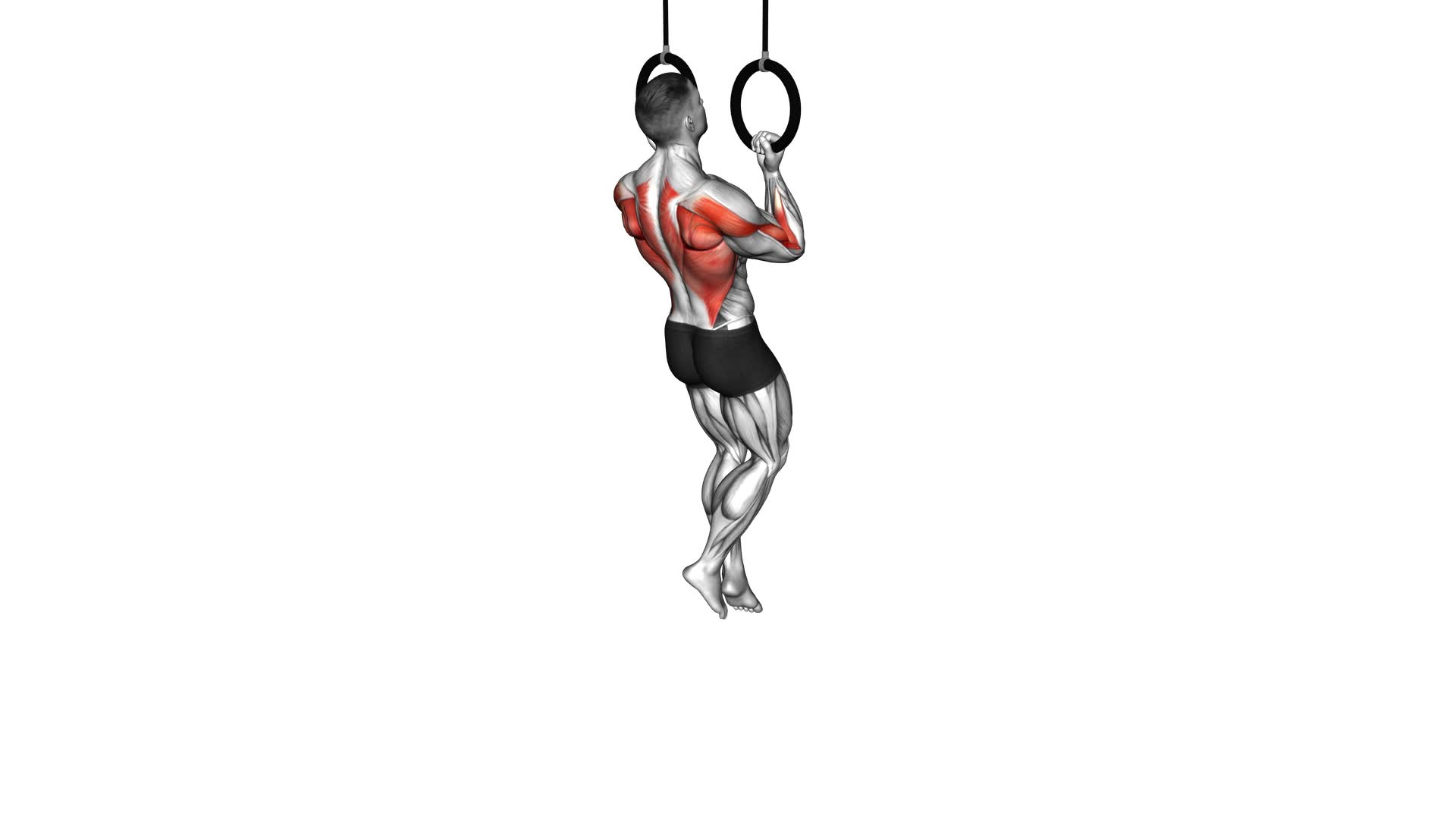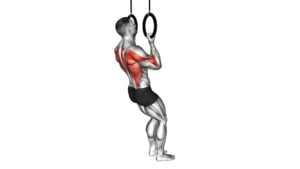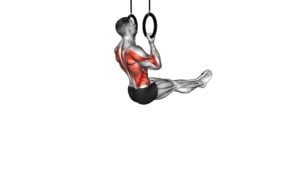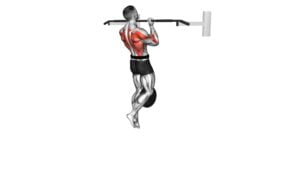Ring Chin-up (male) – Video Exercise Guide & Tips

Looking to strengthen your upper body? Get ready to take your chin-ups to the next level with our video exercise guide and tips for the ring chin-up.
Watch This Exercise Video
This intensive workout targets your back, arms, and core muscles, providing maximum results in minimal time.
Learn the proper form and technique, explore variations and progressions, and discover common mistakes to avoid.
Get ready to challenge yourself and achieve your fitness goals with this effective exercise.
Key Takeaways
- Ring chin-ups are an effective exercise for improving grip strength.
- They activate muscles in the upper body, including the biceps, back, shoulders, and core.
- Ring chin-ups provide greater muscle activation compared to traditional chin-ups.
- Variations and progressions, such as weighted ring chin-ups and L-sit ring chin-ups, can help challenge and further improve strength and stability.
Benefits of Ring Chin-ups
You should regularly incorporate ring chin-ups into your workout routine to maximize the benefits for your upper body strength and muscle development. Ring chin-ups are an effective exercise for improving grip strength and activating muscles in your upper body.
Compared to traditional chin-ups, ring chin-ups provide a greater challenge to your grip due to the instability of the rings. This increased demand on your grip strength translates to improved overall grip strength, which is essential for various activities in daily life and other exercises.
Additionally, ring chin-ups require more muscle activation compared to traditional chin-ups. The instability of the rings forces your muscles to work harder to stabilize your body during the movement, engaging a greater number of muscles in your upper body, including the biceps, back, shoulders, and core.
This increased muscle activation leads to greater muscle development and strength gains. By incorporating ring chin-ups into your workout routine, you can effectively target your upper body muscles and improve both grip strength and overall muscle development.
Proper Form and Technique
How can you ensure proper form and technique while performing a ring chin-up?
Proper form and technique are crucial when performing a ring chin-up to maximize its benefits and prevent injuries. One common misconception is that swinging your body and using momentum will make the exercise easier. However, this can actually compromise your form and decrease the effectiveness of the exercise.
To maintain proper form, start by gripping the rings with an overhand grip, shoulder-width apart. Keep your body straight, engage your core, and retract your shoulder blades. As you pull yourself up, focus on using your back muscles and keeping your elbows tucked in. Avoid jerking or using your legs to assist you. Slowly lower yourself back down to the starting position, maintaining control throughout the movement.
When performing ring chin-ups, the only equipment needed is a set of rings that can be securely hung overhead. By following these proper form and technique guidelines, you can effectively target your back and arm muscles while minimizing the risk of injury.
Now, let's explore some variations and progressions to challenge yourself further.
Variations and Progressions
To challenge yourself further in ring chin-ups, explore different variations and progressions. Here are three advanced techniques to take your muscle activation to the next level:
- Weighted Ring Chin-ups: Attach a weight plate or a dumbbell to your body using a weight belt or a harness. This added resistance will increase the intensity of the exercise and help you build more strength in your upper body.
- L-Sit Ring Chin-ups: Perform a standard ring chin-up, but instead of keeping your legs hanging freely, lift them up and straighten them out in front of you. This variation not only targets your back and biceps but also engages your core muscles, making it a challenging full-body exercise.
- Archer Ring Chin-ups: Start in a regular ring chin-up position, but as you pull yourself up, reach one arm out to the side, mimicking the motion of drawing a bow and arrow. This variation helps improve unilateral strength and stability in your upper body.
By incorporating these advanced techniques into your ring chin-up routine, you can continue to challenge your muscles and make progress towards your fitness goals.
Now, let's move on to the next section and discuss common mistakes to avoid.
Common Mistakes to Avoid
Moving from the previous subtopic on variations and progressions, let's now delve into common mistakes to avoid when performing ring chin-ups. It's important to be aware of these common errors and to correct them in order to maximize the effectiveness and safety of your workout.
One common mistake isn't fully engaging the muscles in your back and shoulders. To correct this, focus on squeezing your shoulder blades together and pulling your chest towards the rings as you perform the chin-up. This will ensure that you're targeting the correct muscles and getting the most out of the exercise.
Another mistake is using too much momentum to lift yourself up. This can take away from the effectiveness of the exercise and increase the risk of injury. Instead, focus on using controlled movements and relying on your muscles to do the work. This will help to build strength and stability in your upper body.
Finally, avoid swinging your body or using excessive swinging movements during the exercise. This can put strain on your joints and decrease the effectiveness of the chin-up. Instead, aim for a stable and controlled movement, keeping your body as still as possible.
Tips for Maximizing Results
To maximize your results, focus on maintaining proper form and incorporating progressive overload into your ring chin-up routine. Here are some tips to help you achieve the best possible outcome:
- Progress Tracking: Keep a record of your workouts to monitor your progress over time. This will help you identify areas where you can improve and set achievable goals. Tracking your progress can also provide a sense of accomplishment and motivation to keep pushing yourself.
- Nutrition Tips: Fuel your body with the right nutrients to support muscle growth and recovery. Make sure you consume enough protein to repair and build muscles. Incorporate healthy carbohydrates for energy and include a variety of fruits and vegetables for essential vitamins and minerals. Stay hydrated by drinking plenty of water throughout the day.
- Rest and Recovery: Give your body enough time to rest and recover between workouts. This allows your muscles to repair and grow stronger. Aim for at least 48 hours of rest before targeting the same muscle group again. Getting enough sleep is also crucial for optimal recovery and performance.
Frequently Asked Questions
How Many Sets and Repetitions Should I Do for Ring Chin-Ups for Optimal Results?
For optimal results with ring chin-ups, it's important to consider the number of sets and repetitions you do. The recommended rest time between sets is typically around 90 seconds to two minutes. This allows your muscles to recover and perform at their best.
Common mistakes to avoid include using improper form, not fully extending your arms, and not engaging your core.
Can Ring Chin-Ups Help Improve My Grip Strength?
Ring chin-ups can definitely help improve your grip strength. By using rings instead of a bar, you engage more muscles in your forearms to stabilize yourself during the exercise. This increased demand on your forearm muscles leads to improved grip strength over time.
Additionally, ring training offers a variety of benefits, such as increased upper body strength and stability. So incorporating ring chin-ups into your routine can't only improve your grip strength but also provide overall benefits to your fitness.
Are Ring Chin-Ups Suitable for Beginners?
Ring chin-ups can be a challenging exercise, especially for beginners. It's important to start with a proper ring chin-up progression to build strength and avoid injury.
Common mistakes in ring chin-ups include swinging or using momentum, which can hinder progress and strain your muscles. Take it slow, focus on proper form and technique, and gradually increase the difficulty level.
With consistency and patience, you'll be able to master ring chin-ups and improve your overall fitness.
What Muscles Are Primarily Targeted During Ring Chin-Ups?
During ring chin-ups, the primary muscles targeted are the back muscles, including the latissimus dorsi and rhomboids. These exercises are great for building upper body strength and improving your overall fitness.
Ring chin-ups also engage the biceps, shoulders, and forearms. For advanced athletes, there are variations and progressions available to further challenge your muscles and enhance your performance.
Incorporating ring chin-ups into your workout routine can provide numerous benefits for your upper body strength.
Can Ring Chin-Ups Help With Improving Posture?
Ring chin-ups can definitely help improve your posture. By using rings instead of a fixed bar, you engage more stabilizer muscles, promoting better alignment and reducing the risk of imbalances.
As you progress, you can start with assisted ring chin-ups, using a resistance band or partner, and gradually decrease assistance until you can perform unassisted ring chin-ups. This progression builds strength in your back, shoulders, and core, all of which are crucial for maintaining good posture.
Conclusion
In conclusion, ring chin-ups are an effective exercise that offers numerous benefits for both strength and muscle development.
By maintaining proper form and technique, individuals can maximize their results and avoid common mistakes.
Variations and progressions can be incorporated to continuously challenge and improve performance.
Remember to always prioritize safety and consult with a professional trainer if needed.
With dedication and consistency, ring chin-ups can be a valuable addition to any fitness routine.

Author
Years ago, the spark of my life’s passion ignited in my mind the moment I stepped into the local gym for the first time. The inaugural bead of perspiration, the initial endeavor, the very first surge of endorphins, and a sense of pride that washed over me post-workout marked the beginning of my deep-seated interest in strength sports, fitness, and sports nutrition. This very curiosity blossomed rapidly into a profound fascination, propelling me to earn a Master’s degree in Physical Education from the Academy of Physical Education in Krakow, followed by a Sports Manager diploma from the Jagiellonian University. My journey of growth led me to gain more specialized qualifications, such as being a certified personal trainer with a focus on sports dietetics, a lifeguard, and an instructor for wellness and corrective gymnastics. Theoretical knowledge paired seamlessly with practical experience, reinforcing my belief that the transformation of individuals under my guidance was also a reflection of my personal growth. This belief holds true even today. Each day, I strive to push the boundaries and explore new realms. These realms gently elevate me to greater heights. The unique combination of passion for my field and the continuous quest for growth fuels my drive to break new ground.



